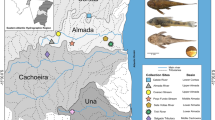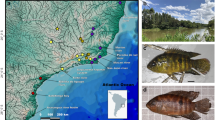Abstract
The sinipercids represent a group of 12 species of freshwater percoid fish, including nine in Siniperca and three species in Coreoperca. Despite several classification attempts and a preliminary molecular phylogeny, the phylogenetic relationships and systematic position of sinipercids remained still unsolved. The complete cytochrome b gene sequences from nine sinipercid species four non-sinipercid fish species were cloned, and a total of 12 cyt b sequences from 10 species of sinipercids and 11 cyt b sequences from 10 species of non-sinipercid fish also in Perciformes were included in the phylogenetic analysis. As expected, the two genera Siniperca and Coreoperca within sinipercids are recovered as monophyletic. However, nine species representing Moronidae, Serranidae, Centropomidae, Acropomatidae, Emmelichtyidae, Siganidae and Centrarchidae included in the present study are all nested between Coreoperca and Siniperca, which provides marked evidence for a non-monophyly of sinipercid fishes. Coreoperca appears to be closest to Centrachus representing the family Centrarchidae. Coreoperca whiteheadi and C. herzi are sibling species, which together are closely related to C. kawamebari. In the Siniperca, the node between S. roulei and the remaining species is the most ancestral, followed by that of S. fortis. S. chuatsi and S. kneri are sibling species, sister to S. obscura. However, the sinipercids do not seem to have a very clear phylogenetic history, for different methods of phylogenetic reconstruction result in different tree topologies, and the only conclusive result in favor of a paraphyletic origin of the two sinipercid genera is the parametric bootstrap test. The paraphyly of Sinipercidae may suggest that the “synapomorphs” such as cycloid scales, upon which this family is based, were independently derived at least twice within sinipercid fishes, and further study should be carried out to include the other two Siniperca species and to incorporate other genes.




Similar content being viewed by others
References
Akaike, H., 1974. A new look at the statistical model identification. IEEE Transactions on Automatic Control 19: 716–723.
Cao, Y., K. Kim, J. Ha & M. Hasegawa, 1999. Model dependence of the phylogenetic inference: relationship among carnivores, perissodactyls and cetartiodactyls as inferred from mitochondrial genome sequences. Genes & Genetic Systems 74: 211–213.
Cavender, T. M., 1986. Review of the fossil history of North American freshwater fishes. In Hocutt C. H. & E. O. Wiley (eds), The Zoogeography of North American freshwater fishes. Wiley, New York: 699–724.
Doi, T., S. Aoyama & I. Kinoshita, 2004. Ontogeny of the mandarinfish Siniperca chuatsi (Perciformes: Sinipercidae) reared in aquarium. Ichthyological Research 51: 337–342.
Engstrom, T. N., H. B. Shaffer & W. Mccord, 2004. Multiple data sets, high homoplasy, and the phylogeny of softshell turtles (Testudines: Trionychidae) Systematic Biology 53: 693–710.
Esposti, M. D., S. De Vries, M. Crimi, A. Ghelli, T. Patarnello & A. Meyer, 1993. Mitochondrial cytochrome b: evolution and structure of the protein. Biochimica et Biophysica Acta 1143: 243–271.
Goldman, N., J. P. Anderson & A. G. Rodrjgo, 2000. Likelihood-based tests of topologies in phylogenetics. Systematic Biology 49: 652–670.
Gosline, W. A., 1966. The limits of the fish family Serranidae, with notes on other lower percoids. Proceedings of the California Academy of Sciences 33: 91–112.
Griffiths, C. S., 1997. Correlation of functional domains and rates of nucleotide substitution in cytochrome b. Molecular Phylogenetics and Evolution 7: 352–365.
Gu, X. & W. H. Li, 1998. Estimation of evolutionary distances under stationary and nonstationary models of nucleotide substitution. Proceedings of the National Academy of Sciences of the United States of America 95: 5899–5905.
Guo, X., S. He & Y. Zhang, 2005. Phylogeny and biogeography of Chinese sisorid catifhes re-examined using mitochondrial cytochrome b and 16S rRNA gene sequences. Molecular Phylogenetics and Evolution 35: 344–362.
Hillis, D. M., 1996. Inferring complex phylogenies. Nature 383: 130–131.
Hillis, D. M., 1998. Taxonomic sampling, phylogenetic accuracy, and investigation bias. Systematic Biology 47: 3–8.
Hillis, D. M. & J. P. Huelsenbeck, 1992. Signal, noise, and reliability in molecular phylogenetic analyses. The Journal of Heredity 83: 189–195.
Hillis, D. M. & T. P. Wiocox, 2005. Phylogeny of the New World true frogs (Rana). Molecular Phylogenetics and Evolution 34: 299–314.
Huelsenbeck, J. P. & F. Ronquist, 2001. MrBayes: Bayesian inference of phylogeny. Bioinformatics 17: 754–755.
Huelsenbeck, J. P., D. M. Hillis & R. Nielsen, 1996. A likelihood-ratio test of monophyly. Systematic Biology 45: 546–558.
Johnson, G. D., 1984. Percoidei: development and relationships. In Moser, H. G., W. J., Richards, D. M., Cohen & M. P., Fahay (eds), Ontogeny and systematics of fishes. American Society of Ichthyologists and Herpetologists, Special Publication 1: 464–498.
Katayama, M., 1960. Fauna Japonica: Serranidae (Pisces). Biogeographical Society of Japan, Tokyo.
Liu, C. H., 1985. The interesting marine fishes of Taiwan. Taiwan provincial department of education, Taiwan, R.O.C.
Liu, H. & Y. Chen, 1994. Phylogeny of the sinipercine fishes with some taxonomic notes. Zoological Research 15 (Suppl.): 1–12.
Liu, H., 1997. Study on systematic position of sinipercine fishes with discussion on relationships of some lower perciforms. Transaction of the Chinese Ichthyological Society 6: 1–7.
Maddison, W. P., D. R. Maddison, 2005. Mesquite: a modular system for evolutionary analysis. Version 1.06. http://mesquiteproject.org.
Miya, M., H. Takeshima, H. Endo, N. G. Ishiguro, J. Inoue, T. Mukai, T. P. Satoh, M. Yamaguchi, A. Kawaguchi, K. Mabuchi, S. M. Shirai & M. Nishida, 2003. Major patterns of higher teleostean phylogenies: a new perspective based on 100 complete mitochondrial DNA sequences. Molecular Phylogenetics and Evolution 26: 121–138.
Near, T. J., J. C. Porterfield & L. M. Page, 2000. Evolution of cytochrome b and the molecular systematics of Ammocrypta (Percidae: Etheostomatinae). Copeia 2000: 701–711.
Nelson, J. S., 1994. Fishes of the World. 3rd edn. John Wiley, Sons, Inc, New York.
Orrell, T. M., K. E. Carpenter, J. A. Musick & J. E. Graves, 2002. Phylogenetic and biogeographic analysis of the Sparidae (Perciformes: Percoidei) from cytochrome b Sequences. Copeia 3: 618–631.
Perdices, A., C. Cunha & M. M. Coelho, 2004. Phylogenetic structure of Zacco platypus (Teleostei, Cyprinidae) populations on the upper and middle Chang Jiang (=Yangtze) drainage inferred from cytochrome b sequences. Molecular Phylogenetics and Evolution 31: 192–203.
Pollock, D. D., D. J. Zwickl, J. A. Mcguire & D. M. Hillis, 2002. Increased taxon sampling is advantageous for phylogenetic inference. Systematic Biology 51: 664–671.
Posada, D. & K. A. Crandall, 1998. Modeltest: testing the model of DNA substitution. Bioinformatics 14: 817–818.
Posada, D. & T. R. Buckley, 2004. Model selection and model averaging in phylogenetics: advantages of akaike information criterion and Bayesian approach. Systematic Biology 53: 793–808.
Roberts, C. D., 1993. Comparative morphology of spined scales and their phylogenetic significance in the Teleostei. Bulletin of Marine Science 52: 60–113.
Roe, K. J., P. M. Harris & R. L. Mayden, 2002. Phylogenetic relationships of the genera of North American sunfishes and basses (Percoidei: Centrarchidae) as evidenced by the mitochondrial cytochrome b gene. Copeia 4: 897–905.
Ruedi, M., M. Auberson & V. Savolainen, 1998. Biogeography of sulawesian shrews: testing for their origin with parametric bootstrap on moleuclar data. Molecular Phylogenetics and Evolution 9: 567–571.
Shimodaira, H. & M. Hasegawa, 1999. Multiple comparisons of log-likelihoods with applications to phylogenetic inference. Molecular Biology and Evolution 16: 1114–1116.
Shimodaira, H. & M. Hasegawa, 2001. CONSEL: for assessing the confidence of phylogenetic tree selection. Bioinformatics 17: 1246–1247.
Shimodaira, H., 2002. An approximately unbiased test of phylogenetic tree selection. Systematic Biology 51: 492–508.
Shirai, S. M., Y. Yabumoto, I. Kim & C. Zhang, 2003. Phylogeny of sinipercid fishes and their relatives inferred from mtDNA cytochrome b gene: a preliminary study. Bulletin of Kitakyushu Museum of National History and Human History Series A 1: 45–49.
Strimmer, K. & A. Rambaut, 2002. Inferring confidence sets of possibly misspecified gene trees. Phylosophical Transactions of the Royal Society B: Biological Science 269: 137–142.
Swofford, D. L., G. J. Olsen, P. J. Waddell & D. M. Hillis, 1996. Phylogenetic inference. In Hillis D. M., C. Mortiz & B. K. Mable (eds), Molecular Systematics, 2nd edn. Sinauer, Associates, Sunderland, Massachusetts: 407–514.
Swofford, D.L., 2002. PAUP*. Phylogenetic Analysis Using Parsimony (*and other methods). Version 4. Sinauer, Sunderland, MA.
Templeton, A. R., 1983. Phylogenetic inference from restriction endonuclease cleavage site maps with particular reference to the evolution of humans and the apes. Evolution 37: 221–244.
Thompson, J. D, T. J. Gibson, F. Plewniak, F. Jeanmougin & D. G. Higgins, 1997. The Clustal X windows interface: flexible strategies for multiple sequences alignment aided by quality analysis tools. Nucleic Acids Research 25: 4876–4882.
Voelker, G. K & S. V. Edwards, 1998. Can weighting improve bushy trees? Models of cytochrome b evolution and the molecular systematics of pipits and wagtails (Aves: Motacillidae). Systematic Biology 47: 589– 603.
Waldman, J. R., 1986. Systematics of Morone (Pisces: Moronidae), with notes on the lower percoids. Ph. D. thesis, Department of Biology, The City University of New York, New York.
Xiao, W., Y. Zhang & H. Liu, 2001. Molecular systematics of Xenocyprinae (Teleostei: Cyprinidae): taxonomy, biogeography, and coevolution of a special group restricted in East Asia. Molecular Phylogenetics and Evolution 18: 163–173.
Yabumoto, Y. & T. Uyeno, 2000. Inabaperca taniurai, a new genus and species of Miocene percoid fish from Tottori Prefecture, Japan. Bulletin of National Science of Museum, Tokyo, Series C (Geology & Paleontology) 26: 93–106.
Zheng, C., 1989. Fishes of the Zhujiang River. Science Press, Beijing.
Zhou, C., Q. Yang & D. Cai, 1988. On the classification and distribution of the sinipercinae fishes (family Serranidae). Zoological Research 9: 113–125.
Zwickl, D. J. & D. M. Hillis, 2002. Increased taxon sampling greatly reduces phylogenetic error. Systematic Biology 51: 588–598.
Acknowledgements
We extend our sincerest gratitude to Dr. D. Wang, Dr. L. Zhou, and Mrs. M. Pan for assistance in collecting specimens. We thank Dr. Y. Yabumoto for providing some literatures. We gracefully acknowledge the two anonymous reviewers whose critical review and insightful suggestions have improved the clarity and focus of the manuscript. This study was supported by grants (project no. 30130150) from the National Natural Science Foundation of China, and a grant (project no. [2005] 192) from the Chinese Academy of Sciences.
Author information
Authors and Affiliations
Corresponding author
Additional information
Handling editor: C. Sturmbauer
Rights and permissions
About this article
Cite this article
Chen, D., Guo, X. & Nie, P. Non-monophyly of fish in the Sinipercidae (Perciformes) as inferred from cytochrome b gene. Hydrobiologia 583, 77–89 (2007). https://doi.org/10.1007/s10750-006-0478-4
Received:
Revised:
Accepted:
Published:
Issue Date:
DOI: https://doi.org/10.1007/s10750-006-0478-4




